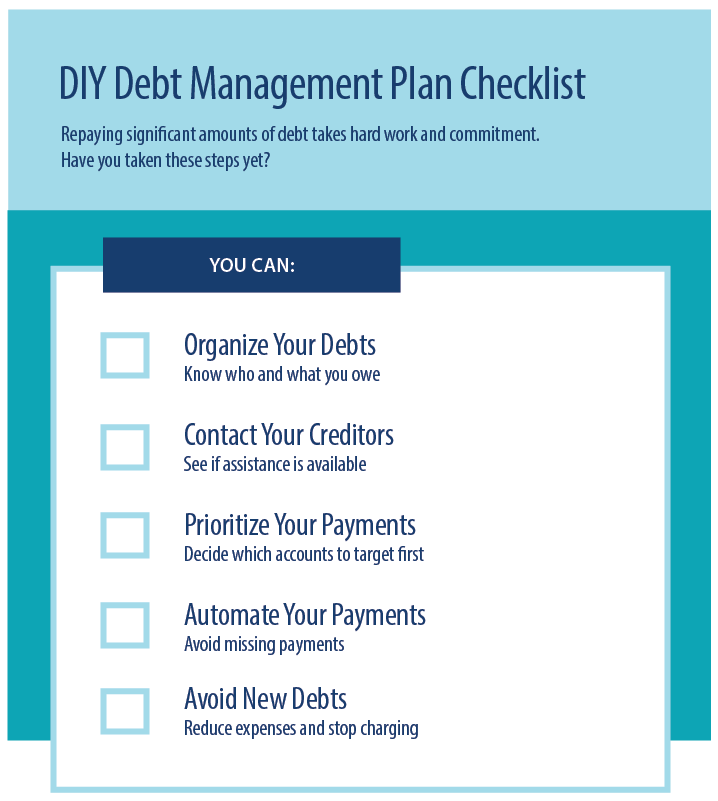Real-Life Success Stories of Financial Obligation Loan Consolidation: More Discussion Posted Here
Real-Life Success Stories of Financial Obligation Loan Consolidation: More Discussion Posted Here
Blog Article
Whatever You Required to Learn About Developing an Individualized Debt Monitoring Plan
In the world of personal financing, designing a tailored financial obligation monitoring plan is usually the foundation of attaining financial stability and assurance. By carefully examining your existing financial commitments, setting achievable monetary purposes, and crafting a useful spending plan, you lead the way for reliable financial debt settlement approaches. Nonetheless, the trip to monetary flexibility is not entirely about initial preparation; it additionally needs recurring surveillance and changes to make certain continued development. As you navigate the intricacies of producing a personalized financial obligation administration strategy, understanding the intricacies of each step is key to your financial success.
Assessing Your Existing Debt Situation
One must initially conduct a thorough evaluation of their existing financial obligation commitments prior to developing an efficient financial obligation management strategy. Examining your existing debt situation is a critical initial step in gaining control of your finances. Begin by gathering all needed economic files, such as charge card statements, finance arrangements, and any kind of exceptional costs. Develop a breakdown of each financial debt, consisting of the complete quantity owed, rates of interest, minimum monthly payments, and due dates. This detailed introduction will offer a clear image of your economic standing and aid focus on which debts to deal with first.
After assembling this details, compute your complete debt-to-income proportion by dividing your month-to-month debt payments by your monthly earnings. This ratio is a key indicator of your capacity to manage existing debt degrees successfully. Additionally, assess your credit rating report to recognize any mistakes or discrepancies that might be affecting your credit report. Comprehending these facets of your monetary scenario will certainly assist you in developing a personalized financial debt administration plan customized to your specific requirements and goals.
Setup Financial Goals and Targets

When setting monetary goals, it is very important to be particular, quantifiable, attainable, relevant, and time-bound (WISE) For instance, you might set an objective to settle a certain quantity of debt within a particular amount of time, such as lowering your charge card balance by $5,000 in the following 12 months - More Discussion Posted Here. By establishing clear targets like this, you can track your progression and stay encouraged to accomplish your financial debt administration purposes
Furthermore, take into consideration prioritizing your financial debts based upon factors such as rate of interest, superior balances, and repayment terms. By focusing on high-interest debts first, you can conserve cash in the lengthy run and accelerate your journey toward financial flexibility. Bear in mind, each individual's financial scenario is unique, so tailor your targets and more helpful hints goals to fit your individual demands and scenarios.
Producing a Realistic Spending Plan
Crafting a distinct spending plan is a basic action in efficient financial obligation administration and monetary planning. A realistic budget offers as a roadmap for your monetary health and wellness, helping you track your earnings, expenditures, and financial debt settlements. To produce a functional budget, beginning by detailing all your resources of earnings.
When setting budget plan limitations, be straightforward with yourself regarding your spending routines and financial commitments. Assign a section of your income in the direction of settling financial obligation while ensuring you have some funds for savings and emergencies. Consistently testimonial and readjust your spending plan as needed to stay on track with your economic objectives and financial obligation payment plan. By sticking to a reasonable budget plan, you can properly manage your financial obligation and work in the direction of an extra safe and secure economic future.
Checking Out Financial Obligation Settlement Methods
After developing a realistic budget plan, the following essential action in reliable financial obligation monitoring is to explore numerous debt payment techniques. One typical strategy is the snowball approach, where you focus on repaying the smallest debts first while making minimum repayments on bigger debts. This method can help build momentum as you see smaller sized financial obligations being gotten rid of, giving motivation to take on bigger ones.
An additional approach is the avalanche you could try these out approach, which includes focusing on financial debts with the highest possible rate of interest rates. By targeting high-interest debts first, you can lower the total amount you pay in rate of interest in time. This method might be extra cost-effective in the future, despite the fact that it might take longer to see specific financial obligations totally settled.
Financial obligation consolidation is an additional alternative where you combine numerous financial debts right into a solitary loan with a reduced rate of interest. This can simplify your payment process and possibly decrease the total rate of interest paid. However, it's essential to carefully take into consideration the costs and terms associated with consolidation to guarantee it's the appropriate option for your financial scenario.
Tracking and Changing Your Strategy

Changing your strategy might involve reallocating funds to deal with high-interest financial obligations initially, working out with lenders for reduced rates of interest or much better settlement terms, or discovering additional revenue sources to speed up financial obligation settlement. As your economic scenario evolves, your financial obligation administration strategy must adjust appropriately to remain reliable. By staying positive and versatile in monitoring and changing your strategy, you can enhance your efforts towards paying off your financial debts efficiently and achieving your financial goals.
Final Thought
Finally, producing an individualized debt administration plan involves assessing existing debt, setting economic objectives, producing a sensible spending plan, discovering settlement techniques, and monitoring and readjusting the plan as needed. By adhering to these steps, individuals can take control of their financial situation and job in the direction of coming to be debt-free. It is crucial to remain regimented and committed to the strategy in order to accomplish long-term monetary security.
One have to initially carry out a thorough examination of their present debt commitments before formulating a reliable financial obligation monitoring plan.After establishing a practical budget plan, the following important action in reliable financial obligation monitoring is to check out numerous financial obligation settlement techniques - More Discussion Posted Here.To properly manage your debt, continuous surveillance and adjustment of your financial obligation monitoring strategy are essential elements for long-term economic security.Changing your plan might entail reallocating funds to deal with high-interest financial obligations initially, working out with lenders for reduced interest prices or far better repayment terms, or checking out additional income resources to accelerate financial obligation settlement.In conclusion, producing a tailored debt monitoring plan includes assessing current financial debt, setting monetary objectives, producing a practical budget plan, discovering repayment techniques, and surveillance and changing the plan as required
Report this page